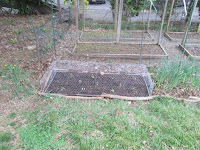When I made the last-minute decision to throw some strawberries in with this year's garden seed order, my plan was to sow the seeds directly in the sloped area of our back yard. I figured if they managed to take root, we could gradually plant more each year until they'd replaced all the grass in that area, and then we wouldn't have to mow it anymore. And if they didn't, oh well, we'd only be out two bucks.
But Brian had a different idea. Our secondary asparagus patch in the back yard wasn't faring too well; the new asparagus crowns we'd planted four years ago in the secondary asparagus bed, next to the rhubarb, had never sent up more than a few spindly tendrils. Last fall, Brian suspected it was entirely dead, and he ended up digging out half of the bed and planting our garlic crop there, next to the rhubarb. So he thought perhaps the remainder of that bed, on the end, would be the best place for the strawberries. The plants wouldn't have any weeds to compete with, and we'd be able to cover them and protect them from predators, increasing our chances of actually getting to eat at least some of the berries.
In the end, we did a little bit of both. We started about half the seeds indoors, using a greenhouse kit someone had given us. As they grew, Brian transplanted the biggest and healthiest-looking ones out of their little greenhouse cells into small pots that gave them a bit more room to spread out. And the remainder of the seeds got planted directly into the ground in that sloped area, where they can fight it out with the grass and weeds.
A complication in Brian's plan came up when the remaining asparagus plants in the proposed strawberry bed poked up a couple of tentative little shoots this month. Rather than kill these plucky survivors, he decided to dig them up and transfer them to our primary asparagus bed on the south side of the house. It hadn't been performing any too well either, not giving us more than a pound or so a year, so he figured it could use all the help it would get. So he crammed the two surviving asparagus crowns into that bed, along with three new ones we'd picked up at Ocean State Job Lot. We don't know yet how well they'll do in their new home, but they definitely have more of a chance there than they did in the back.
With that area cleared, it was time to put the strawberries in the ground. The packet said they'd do best in soil that was "rich and loose with good drainage." Our heavy clay soil meets only one of those criteria, so we amended it beforehand by mixing in most of a bag of composted manure (tested ahead of time to make sure it wasn't "killer compost") and about a quart of sand (left over from our patio project years ago). I just dumped the bag of compost out in the center of the bed, broke up the big clods with gloved hands, and spread it out across the area. Then I added the sand and raked it in.
The final step was to build some sort of cage for pest protection. Since this bed isn't within any sort of fenced-in area, Brian wanted to make sure the plants had cover right from the get-go. So after I'd gone inside to get cleaned up, he stayed out there for another hour or so, fashioning a box out of chicken wire and bamboo stakes. According to the seed packet, the plants will grow to a height of 8 to 10 inches, so he made it about a foot tall to give them a little extra clearance. That way no part of the plants will poke out and allow groundhogs or deer to chomp on it.
Now all that remains is to keep the berries watered and weeded and see how they do. Since this variety (Red and Yellow Wonder Blend), doesn't produce runners, the bed shouldn't need to be thinned out every spring. However, the packet says they will only produce well for two years and recommends adding new plants every year for good production. But we'll wait and see how they perform this first year before deciding whether it's worth the trouble of starting and planting out more in the years to come.






No comments:
Post a Comment